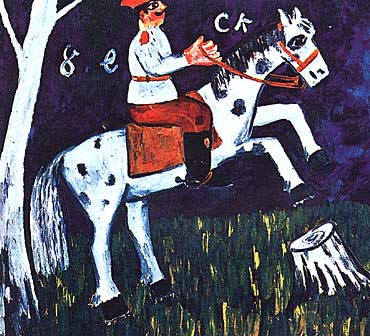 Mikhail Fyodorovich Larionov (1881-1964) Mikhail Fyodorovich Larionov (1881-1964)
Mikhail Fyodorovich Larionov was born in Tiraspol, Moldova on June 3, 1881 and died in Fontenay-aux-Roses, near Paris, on May 10, 1964. He was the son of Fyodor Mikhailovich Larionov, a doctor and a pharmacist, and Aleksandra Fyodorovna Petrovskaya, but he grew up in his grandparents' home in Tiraspol. He attended the Voskresensky Technical High School in Moscow and in 1898 entered the Moscow School of Painting, Sculpture and Architecture. Here he met Natalia Goncharova, who remained his lifelong companion. His imaginative work soon caught the attention of colleagues and critics and in1906 he was invited to exhibit with the Union of Russian Artists and to participate in the Russian Art exhibition at the Salon d'Automne in Paris. When Larionov met Nikolai Ryabushinsky, editor of the "Zolotoe runo" (the Golden Fleece), the famous art mecenas became the artist's chief patron and in 1908 helped him organize the "Golden Fleece" exhibition of the modern French painting in Moscow. As a result of this exhibition, many artists, including Larionov, turned away from Symbolism and started to experiment with Post-Impressionism. In 1910, Larionov was expelled by the Moscow School of Painting for organizing a demonstration against the school's teaching methods. Larionov was the founder of the "Jack of Diamond" group, and with them he exhibited a remarkable series of paintings, among them the Soldiers (1910), created during his military service. Larionov soon deserted the "Jack of Diamond" for the more radical "Donkey's Tail", which held an exhibition in 1912. In 1912 he initiated two very important movements: Rayonism (Rayism) and Neo-primitivism. Rayonism was inspired by Italian Futurism and Neo-primitivism and represented a development of the artist's Fauvist and Expressionist interests.
Rayonism was officially launched at the "Target" exhibition of 1913. In 1914 he traveled with Goncharova to Paris. They held  an exhibition at the Gallerie Paul Guillaume. When the war began, they returned to Russia and Larionov was drafted into the army. He was injured in the battle of the Masurian Lakes and spent three months in a hospital. The injury affected his ability to concentrate and resulted in the decline of his artistic energy. In 1915 he travelled with Goncharova to Switzerland, at the request of Dyaghilev. There he designed for the ballet and gained success. While travelling through Spain and Italy he designed three more ballets, all equally successful. In 1919 he settled permanently in Paris, where he acted as Goncharova's manager. Throughout the decade he worked with Dyaghilev as a designer and artistic adviser. Following Dyaghilev's death in 1929, he resumed painting and also worked occasionally for the ballet. He and Goncharova were granted French citizenship in 1938. In 1950 he suffered a stroke that seriously handicapped his activity and he spent the last 14 years of his life in poverty. an exhibition at the Gallerie Paul Guillaume. When the war began, they returned to Russia and Larionov was drafted into the army. He was injured in the battle of the Masurian Lakes and spent three months in a hospital. The injury affected his ability to concentrate and resulted in the decline of his artistic energy. In 1915 he travelled with Goncharova to Switzerland, at the request of Dyaghilev. There he designed for the ballet and gained success. While travelling through Spain and Italy he designed three more ballets, all equally successful. In 1919 he settled permanently in Paris, where he acted as Goncharova's manager. Throughout the decade he worked with Dyaghilev as a designer and artistic adviser. Following Dyaghilev's death in 1929, he resumed painting and also worked occasionally for the ballet. He and Goncharova were granted French citizenship in 1938. In 1950 he suffered a stroke that seriously handicapped his activity and he spent the last 14 years of his life in poverty.
|













 Culture and Art
Culture and Art  Painting
Painting  XX century
XX century